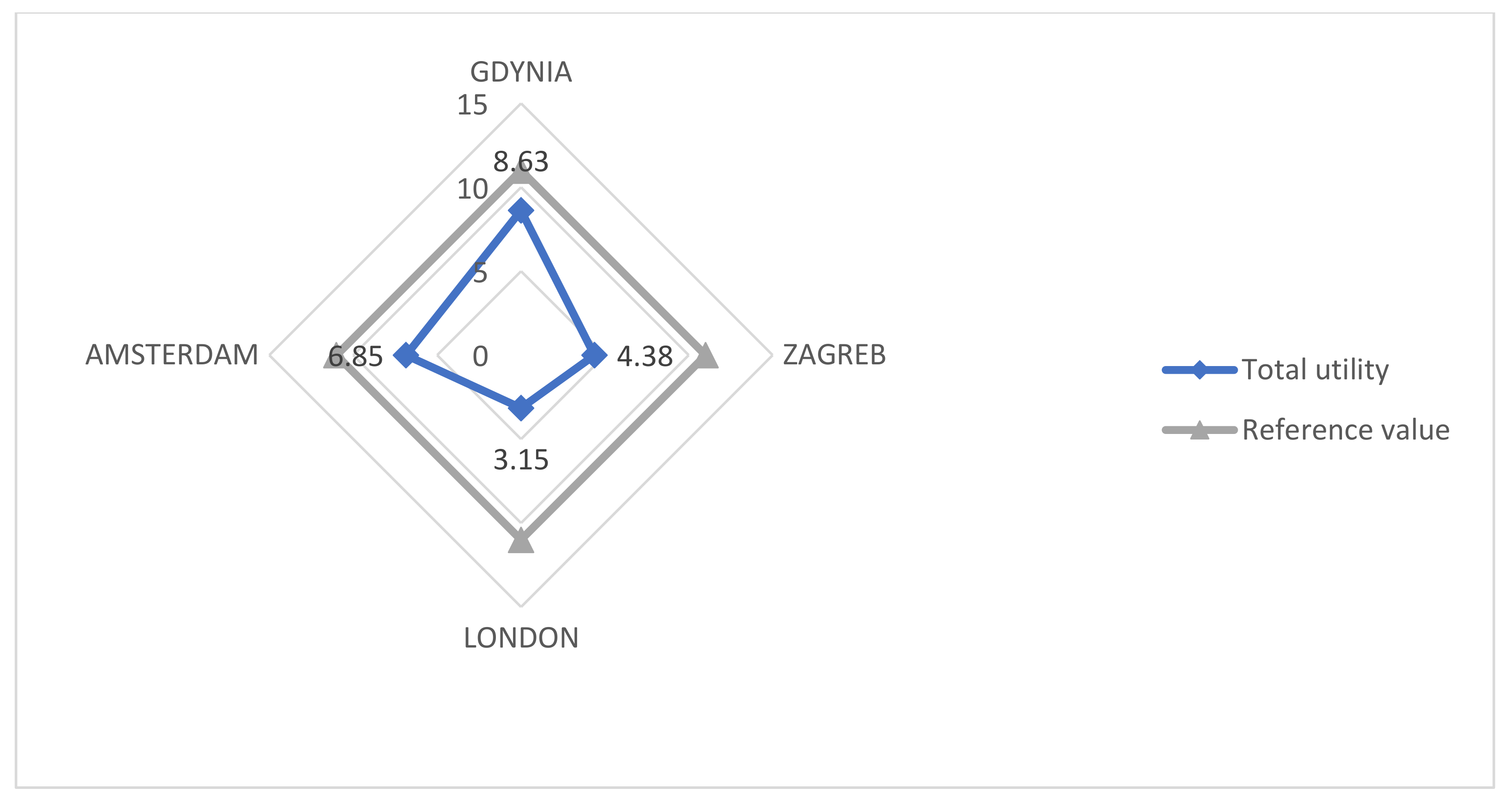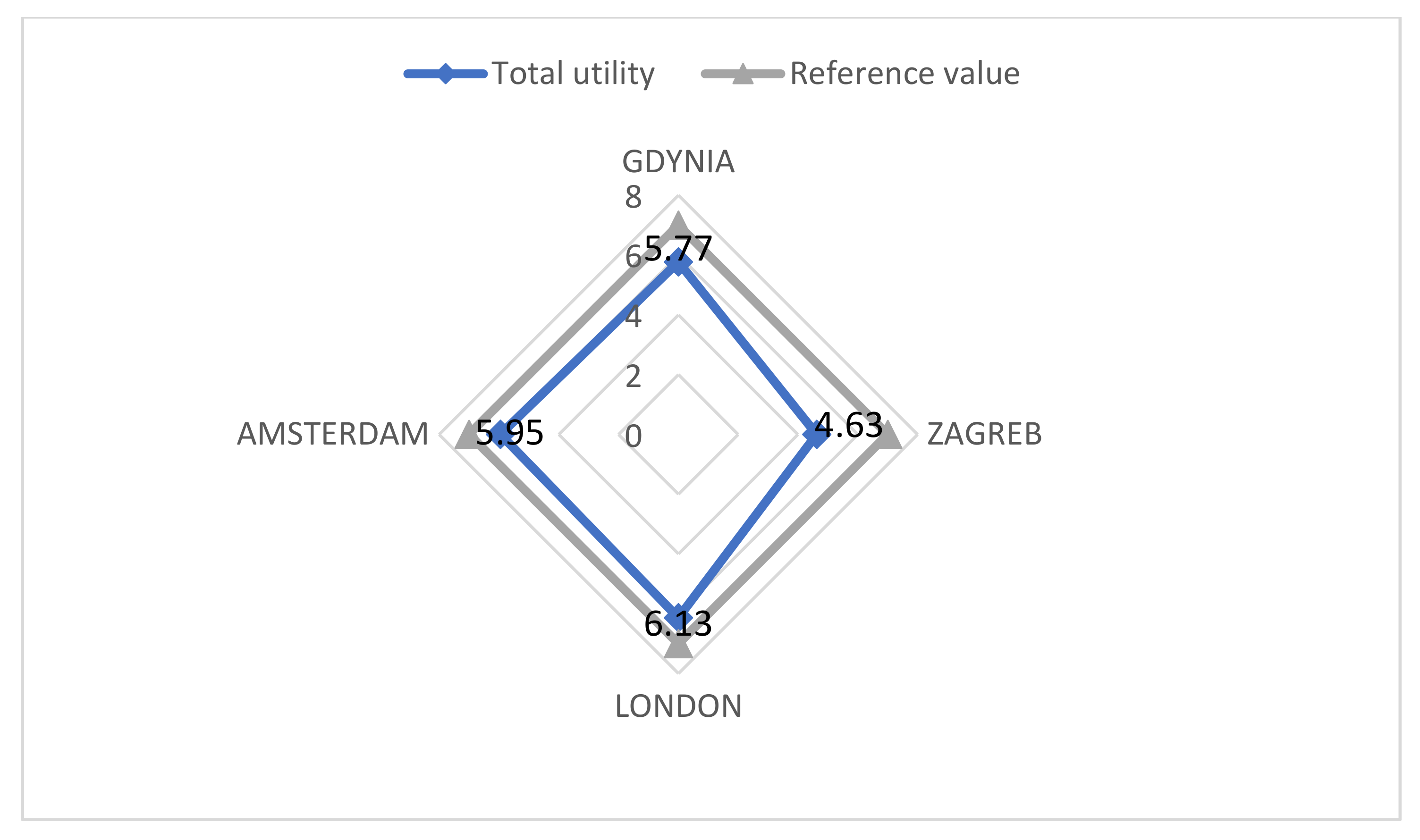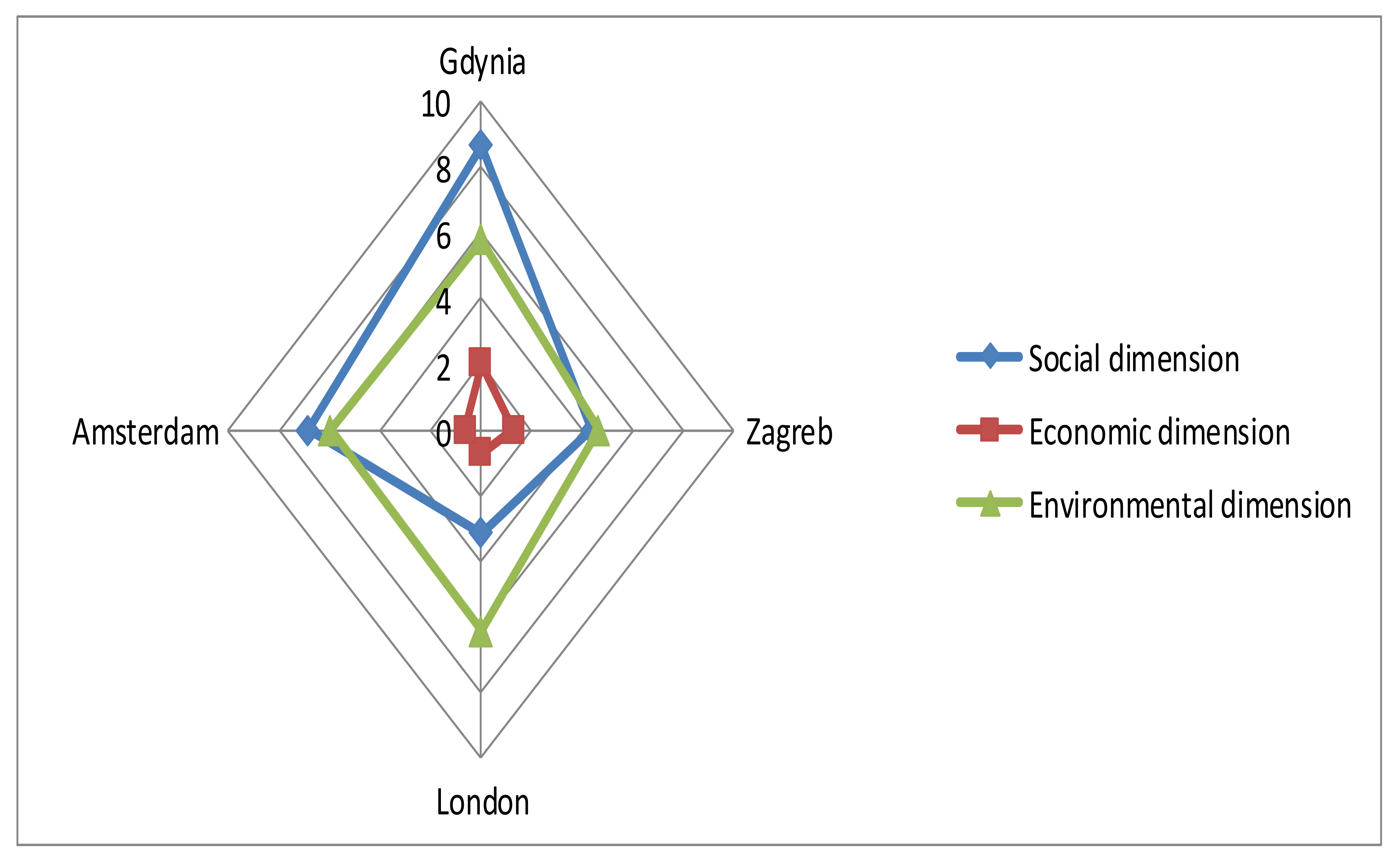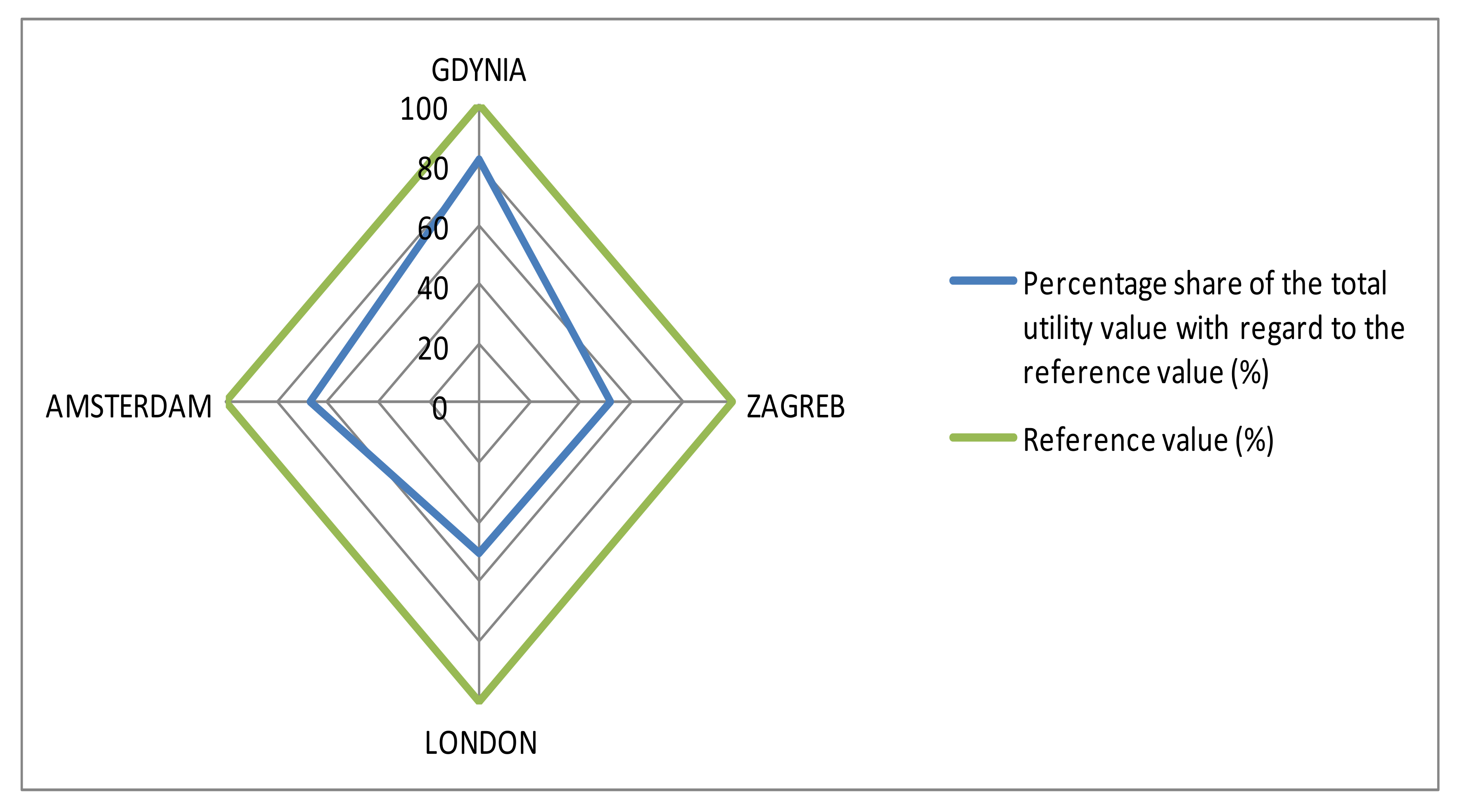Utility Method as an Instrument of the Quality of Life Assessment Using the Examples of Selected European Cities
Abstract
1. Introduction
2. Materials and Methods
- Uij—partial utility for city i relative to indicator j,
- Cij—value of sustainable development indicator j for city i,
- —the lowest (for the sustainable development stimulant) or the highest (for the sustainable development destimulant) value of the sustainable development indicator j among the analyzed cities,
- —the highest (for the sustainable development stimulant) or the lowest (for the sustainable development destimulant) value of the sustainable development indicator j among the analyzed cities.
3. Results
- -
- concentration of fine particulate matter (PM 2.5);
- -
- concentration of particulate matter (PM 10);
- -
- total amount of solid waste collected in the city per capita;
- -
- total water consumption in the city;
- -
- green areas per 100,000 inhabitants;
- -
- number of cars per capita.
4. Discussion
5. Conclusions
Author Contributions
Funding
Data Availability Statement
Conflicts of Interest
References
- McCormick, A. Quality of life. In Cerebral Palsy: A Multidisciplinary Approach, 3rd ed.; Springer: Cham, Switzerland, 2018. [Google Scholar]
- Hiremath, R.B.; Balachandra, P.; Kumar, B.; Bansode, S.S.; Murali, J. Indicator-based urban sustainability—A review. Energy Sustain. Dev. 2013, 17, 555–563. [Google Scholar] [CrossRef]
- Anand, A.; Rufuss, D.D.W.; Rajkumar, V.; Suganthi, L. Evaluation of Sustainability Indicators in Smart Cities for India Using MCDM Approach. Energy Procedia 2017, 141, 211–215. [Google Scholar] [CrossRef]
- Huovila, A.; Bosch, P.; Airaksinen, M. Comparative analysis of standardized indicators for Smart sustainable cities: What indicators and standards to use and when? Cities 2019, 89, 141–153. [Google Scholar] [CrossRef]
- Szpilko, D. Foresight as a Tool for the Planning and Implementation of Visions for Smart City Development. Energies 2020, 13, 1782. [Google Scholar] [CrossRef]
- Jeleński, T.; Dendys, M.; Tomaszewska, B.; Pająk, L.; Tomasz, J. The Potential of RES in the Reduction of Air Pollution: The SWOT Analysis of Smart Energy Management Solutions for Krakow Functional Area (KrOF). Energies 2020, 13, 1754. [Google Scholar] [CrossRef]
- Fandi, G.; Krepl, V.; Ahmad, I.; Igbinovia, F.O.; Ivanova, T.; Fandie, S.; Muller, Z.; Tlusty, J. Design of an Emergency Energy System for a City Assisted by Renewable Energy, Case Study: Latakia, Syria. Energies 2018, 11, 3138. [Google Scholar] [CrossRef]
- Massaro, E.; Athanassiadis, A.; Psyllidis, A.; Binder, C.R.; Wyss, R. Ontology-Based Integration of Urban Sustainability Indicators. In Sustainability Assessment of Urban Systems; Cambridge University Press: Cambridge, UK, 2020; pp. 332–350. [Google Scholar]
- Dali, N.M.; Sarkawi, A.A.; Abdullah, A. An Analytical Study of Malaysia’s Quality of Life Indicators. Population 2017, 8, 488–498. [Google Scholar]
- Niţă, M.R.; Pătroescu, M.; Badiu, D.L.; Gavrilidis, A.A.; Avram, M.-E. Indicators for evaluating the role of green infrastructures in sustainable urban development in Romania. Forum Geogr. 2018, XVII, 75–81. [Google Scholar] [CrossRef]
- Anghelache, C.; Anghel, M.-G. Analysis Models and Methods of the Life Quality in Romania. Rom. Stat. Rev. 2018, 59–86. Available online: http://www.revistadestatistica.ro/wp-content/uploads/2018/06/RRS-2_2018_A5.pdf (accessed on 28 April 2021).
- Mori, K.; Christodoulou, A. Review of sustainability indices and indicators: Towards a new City Sustainability Index (CSI). Environ. Impact Assess. Rev. 2012, 32, 94–106. [Google Scholar] [CrossRef]
- Garau, C.; Pavan, V. Evaluating Urban Quality: Indicators and Assessment Tools for Smart Sustainable Cities. Sustainability 2018, 10, 575. [Google Scholar] [CrossRef]
- Almeida, C.P.; Ramos, A.F.; Silva, J.M. Sustainability assessment of building rehabilitation actions in old urban centres. Sustain. Cities Soc. 2018, 36, 378–385. [Google Scholar] [CrossRef]
- Mittal, S.; Chadchan, J.; Mishra, S.K. Review of Concepts, Tools and Indices for the Assessment of Urban Quality of Life. Soc. Indic. Res. 2019, 149, 187–214. [Google Scholar] [CrossRef]
- Anisetti, M.; Ardagna, C.; Bellandi, V.; Cremonini, M.; Frati, F.; Damiani, E. Privacy-aware Big Data Analytics as a service for public health policies in smart cities. Sustain. Cities Soc. 2018, 39, 68–77. [Google Scholar] [CrossRef]
- Fu, B.; Yu, D.; Zhang, Y. The livable urban landscape: GIS and remote sensing extracted land use assessment for urban livability in Changchun Proper, China. Land Use Policy 2019, 87, 104048. [Google Scholar] [CrossRef]
- Shmelev, S.E.; Shmeleva, I.A. Global urban sustainability assessment: A multidimensional approach. Sustain. Dev. 2018, 26, 904–920. [Google Scholar] [CrossRef]
- Gonzalez-Garcia, S.; Manteiga, R.; Moreira, M.T.; Feijoo, G. Assessing the sustainability of Spanish cities considering environmental and socio-economic indicators. J. Clean. Prod. 2018, 178, 599–610. [Google Scholar] [CrossRef]
- Kaklauskas, A.; Zavadskas, E.; Radzeviciene, A.; Ubarte, I.; Podviezko, A.; Podvezko, V.; Kuzminske, A.; Banaitis, A.; Binkyte, A.; Bucinskas, V. Quality of city life multiple criteria analysis. Cities 2018, 72, 82–93. [Google Scholar] [CrossRef]
- Chiarini, B.; D’Agostino, A.; Marzano, E.; Regoli, A. Air quality in urban areas: Comparing objective and subjective indicators in European countries. Ecol. Indic. 2021, 121, 107144. [Google Scholar] [CrossRef]
- Bugdol, M.; Puciato, D.; Borys, T. Environmental Management Systems in the Context of Sustainable Development—The Identification of Open Problems. Probl. Ekorozw. 2020, 15, 131–142. [Google Scholar] [CrossRef]
- Streimikiene, D. Environmental indicators for the assessment of quality of life. Intellect. Econ. 2015, 9, 67–79. [Google Scholar] [CrossRef]
- Bănică, A.; Istrate, M.; Muntele, I. Towards Green Resilient Cities in Eastern European Union Countries. J. Urban Reg. Anal. 2020, 12. [Google Scholar] [CrossRef]
- Nanaki, E.; Koroneos, C.; Roset, J.; Susca, T.; Christensen, T.; Hurtado, S.D.G.; Rybka, A.; Kopitovic, J.; Heidrich, O.; López-Jiménez, P.A. Environmental assessment of 9 European public bus transportation systems. Sustain. Cities Soc. 2017, 28, 42–52. [Google Scholar] [CrossRef]
- Połom, M.; Tarkowski, M.; Puzdrakiewicz, K.; Dopierała, Ł. Is It Possible to Develop Electromobility in Urban Passenger Shipping in Post-Communist Countries? Evidence from Gdańsk, Poland. Energies 2020, 13, 6362. [Google Scholar] [CrossRef]
- Łebkowski, A. Studies of Energy Consumption by a City Bus Powered by a Hybrid Energy Storage System in Variable Road Conditions. Energies 2019, 12, 951. [Google Scholar] [CrossRef]
- Wołek, M.; Wolański, M.; Bartłomiejczyk, M.; Wyszomirski, O.; Grzelec, K.; Hebel, K. Ensuring sustainable development of urban public transport: A case study of the trolleybus system in Gdynia and Sopot (Poland). J. Clean. Prod. 2021, 279, 123807. [Google Scholar] [CrossRef]
- Neumann, T. The Impact of Carsharing on Transport in the City. Case Study of Tri-City in Poland. Sustainability 2021, 13, 688. [Google Scholar] [CrossRef]
- Witkowski, J.; Kiba-Janiak, M. Correlation between City Logistics and Quality of Life as an Assumption for Referential Model. Procedia Soc. Behav. Sci. 2012, 39, 568–581. [Google Scholar] [CrossRef]
- Kiba-Janiak, M.; Witkowski, J. Sustainable Urban Mobility Plans: How Do They Work? Sustainability 2019, 11, 4605. [Google Scholar] [CrossRef]
- Supangkat, S.H.; Arman, A.A.; Nugraha, R.A.; Fatimah, Y.A. The Implementation of Garuda Smart City Framework for Smart City Readiness Mapping in Indonesia. J. Asia-Pac. Stud. 2018, 32, 169–176. [Google Scholar]
- Wey, W.-M. Constructing urban dynamic transportation planning strategies for improving quality of life and urban sustainability under emerging growth management principles. Sustain. Cities Soc. 2019, 44, 275–290. [Google Scholar] [CrossRef]
- Hernández, J.L.; Garcia, J.; Zubia, C.; Pablos, L.; Cueva, F.; Vasallo, A. Novel sustainability assessment procedure proposal for smart cities. In Proceedings of the Central Europe towards Sustainable Building, Prague, Czech Republic, 22–24 June 2016. [Google Scholar]
- Onat, N.C.; Kucukvar, M.; Aboushaqrah, N.N.; Jabbar, R. How sustainable is electric mobility? A comprehensive sustainability assessment approach for the case of Qatar. Appl. Energy 2019, 250, 461–477. [Google Scholar] [CrossRef]
- Bibri, S.E. The IoT for smart sustainable cities of the future: An analytical framework for sensor-based big data applications for environmental sustainability. Sustain. Cities Soc. 2018, 38, 230–253. [Google Scholar] [CrossRef]
- García-Fuentes, M.Á.; De Torre, C. Towards smarter and more sustainable regenerative cities: The REMOURBAN model. Entrep. Sustain. Issues 2017, 4, 328–338. [Google Scholar] [CrossRef]
- Bobylev, S.N.; Kudryavtseva, O.V.; Solovyova, S.V. Sustainable development indicators for cities. Econ. Reg. 2014, 101–110. [Google Scholar] [CrossRef]
- De Guimarães, J.C.F.; Severo, E.A.; Júnior, L.A.F.; Da Costa, W.P.L.B.; Salmoria, F.T. Governance and quality of life in smart cities: Towards sustainable development goals. J. Clean. Prod. 2020, 253. [Google Scholar] [CrossRef]
- Girardi, P.; Temporelli, A. Smartainability: A Methodology for Assessing the Sustainability of the Smart City. Energy Procedia 2017, 111, 810–816. [Google Scholar] [CrossRef]
- Kapsalis, V.C.; Kyriakopoulos, G.L.; Aravossis, K.G. Investigation of Ecosystem Services and Circular Economy Interactions under an Inter-organizational Framework. Energies 2019, 12, 1734. [Google Scholar] [CrossRef]
- Gravagnuolo, A.; Angrisano, M.; Girard, L.F. Circular Economy Strategies in Eight Historic Port Cities: Criteria and Indicators towards a Circular City Assessment Framework. Sustainability 2019, 11, 3512. [Google Scholar] [CrossRef]
- EC. Smart Cities: Ranking of European Mid-Sized Cities. 2007. Available online: https://ec.europa.eu/digital-agenda/en/smart-cities (accessed on 28 April 2021).
- Petit-Boix, A.; Llorach-Massana, P.; Sanjuan-Delmás, D.; Sierra-Pérez, J.; Vinyes, E.; Gabarrell, X.; Rieradevall, J.; Sanyé-Mengual, E. Application of life cycle thinking towards sustainable cities: A review. J. Clean. Prod. 2017, 166, 939–951. [Google Scholar] [CrossRef]
- Maranghi, S.; Parisi, M.L.; Facchini, A.; Rubino, A.; Kordas, O.; Basosi, R. Integrating urban metabolism and life cycle assessment to analyse urban sustainability. Ecol. Indic. 2020, 112, 106074. [Google Scholar] [CrossRef]
- Bluszcz, A. A Comparative Analysis of Selected Synthetic Indicators of Sustainability. Procedia Soc. Behav. Sci. 2016, 220, 40–50. [Google Scholar] [CrossRef]
- Przybyłowski, A. Global Trends Shaping Life Quality in Agglomerations with Particular Emphasis on Mobility in Seaport Agglomerations. TransNav Int. J. Mar. Navig. Saf. Sea Transp. 2019, 13, 615–620. [Google Scholar] [CrossRef]
- Marsal-Llacuna, M.-L. Building Universal Socio-cultural Indicators for Standardizing the Safeguarding of Citizens’ Rights in Smart Cities. Soc. Indic. Res. 2015, 130, 563–579. [Google Scholar] [CrossRef]
- Garcia, D.A.; Cumo, F.; Pennacchia, E.; Pennucci, V.S.; Piras, G.; De Notti, V.; Roversi, R.; Brebbia, C.A. Assessment of a urban sustainability and life quality index for elderly. Int. J. Sustain. Dev. Plan. 2017, 12, 908–921. [Google Scholar] [CrossRef]
- Calvillo, C.; Sánchez-Miralles, A.; Villar, J. Energy management and planning in smart cities. Renew. Sustain. Energy Rev. 2016, 55, 273–287. [Google Scholar] [CrossRef]
- Mosannenzadeh, F.; Bisello, A.; Vaccaro, R.; D’Alonzo, V.; Hunter, G.W.; Vettorato, D. Smart energy city development: A story told by urban planners. Cities 2017, 64, 54–65. [Google Scholar] [CrossRef]
- Nagaj, R.; Korpysa, J. Impact of COVID-19 on the Level of Energy Poverty in Poland. Energies 2020, 13, 4977. [Google Scholar] [CrossRef]
- Kourtit, K.; Nijkamp, P.; Suzuki, S. Comparative urban performance assessment of safe cities through data envelopment analysis. Reg. Sci. Policy Pract. 2020. [Google Scholar] [CrossRef]
- Hugh, S.; Fox, M.S. Homelessness and Open City Data: Addressing a Global Challenge. In Open Cities|Open Data; Palgrave Macmillan: Singapore, 2019; pp. 29–55. [Google Scholar]
- Banani, R.; Vahdati, M.M.; Shahrestani, M.; Clements-Croome, D. The development of building assessment criteria framework for sustainable non-residential buildings in Saudi Arabia. Sustain. Cities Soc. 2016, 26, 289–305. [Google Scholar] [CrossRef]
- Norouzian-Maleki, S.; Bell, S.; Hosseini, S.-B.; Faizi, M. Developing and testing a framework for the assessment of neighbourhood liveability in two contrasting countries: Iran and Estonia. Ecol. Indic. 2015, 48, 263–271. [Google Scholar] [CrossRef]
- International Organization for Standardization. Sustainable Cities and Communities—Indicators for City Services and Quality of Life; International Organization for Standardization: Geneva, Switzerland, 2018. [Google Scholar]
- Moschen, S.A.; Macke, J.; Bebber, S.; Da Silva, M.B.C. Sustainable development of communities: ISO 37120 and UN goals. Int. J. Sustain. High. Educ. 2019, 20, 887–900. [Google Scholar] [CrossRef]
- Бoртнік, О.В. Implementation of international standards in local government as a key to sustainable development. Public Adm. Asp. 2019, 7, 31–43. [Google Scholar] [CrossRef]
- Da Silva, M.B.C.; Bebber, S.; Fachinelli, A.C.; Moschen, S.D.A.; Perini, R.D.L. City life satisfaction: A measurement for smart and sustainable cities from the citizens’ perspective. Int. J. Knowl.-Based Dev. 2019, 10, 338. [Google Scholar] [CrossRef]
- Lehner, A.; Erlacher, C.; Schlögl, M.; Wegerer, J.; Blaschke, T.; Steinnocher, K. Can ISO-Defined Urban Sustainability Indicators Be Derived from Remote Sensing: An Expert Weighting Approach. Sustainability 2018, 10, 1268. [Google Scholar] [CrossRef]
- Fijałkowska, J.; Aldea, T. Reporting of Sustainable Development of Cities According to ISO 37120. Pr. Nauk. Uniw. Ekon. Wrocławiu 2017, 174–184. [Google Scholar] [CrossRef]
- McCarney, P. The evolution of global city indicators and ISO37120: The first international standard on city indicators. Stat. J. IAOS 2015, 31, 103–110. [Google Scholar] [CrossRef]
- Hurth, V.; McCarney, P. International standards for climate-friendly cities. Nat. Clim. Chang. 2015, 5, 1025–1026. [Google Scholar] [CrossRef]
- Rześny-Cieplińska, J.; Szmelter-Jarosz, A. Stakeholders’ Analysis of Environmental Sustainability in Urban Logistics: A Case Study of Tricity, Poland. Energies 2021, 14, 1274. [Google Scholar] [CrossRef]
- Alpopi, C.; Manole, C.; Colesca, S.E. Assessment of the sustainable urban development level through the use of indicators of sustainability. Theor. Empir. Res. Urban Manag. 2011, 6, 78–87. [Google Scholar]
- Colesca, S.E.; Alpopi, C. Quality of electronic government services. A fuzzy analysis. Qual.-Access Success 2010, 11, 88–95. [Google Scholar]
- Alpopi, C.; Iacoboaea, C.; Stănescu, A. Analysis of the current housing situation in Romania in the European context. Transylv. Rev. Adm. Sci. 2014, 10, 5–24. [Google Scholar]




| Indicator | Unit | Gdynia | Zagreb | London | Amsterdam |
|---|---|---|---|---|---|
| 1. Youth Unemployment—D | % | 8.1 | 31 | 20.18 | 16 |
| 2. Number of Companies per 100,000 Inhabitants—S | number | 15,606 | 11,670 | 10,943 | 11,526 |
| 3. Concentration of Fine Particulate Matter (PM 2.5)—D | µg/m3 | 13.5 | 21.0 | 14.2 | 13.6 |
| 4. Concentration of Fine Particulate Matter (PM 10) (EU standard—40 µg/m3)—D | µg/m3 | 19.3 | 28.5 | 19.3 | 17.0 |
| 5. Concentration of NO2 (EU standard—µg/m3)—D | µg/m3 | 15.2 | 41.2 | 34.7 | 32.9 |
| 6. Debt Servicing Rate—D | % | 1.60 | 3.90 | 7.52 | 8.60 |
| 7. Number of Firefighters per 100,000 Inhabitants—S | number | 130 | 46 | 60 | 61 |
| 8. Ambulance Response Time from Notification Received—D | min. | 5.0 | 2.26 | 7.13 | 9.58 |
| 9. Voter Turnout in the Last Local Elections—S | % | 42.2 | 44.2 | 38.6 | 50.3 |
| 10. Percentage of Women Elected to Office at the Public Municipal Administration—S | % | 41.0 | 30.19 | 30.7 | 39.0 |
| 11. Number of Doctors per 100,000 Inhabitants—S | number | 772 | 528.1 | 279.3 | 496.9 |
| 12. Number of Internet Connections per 100,000 Inhabitants—S | number | 45,141 | 31,445 | 32,164 | 49,463 |
| 13. Under-Five Mortality Rate per 1000 Live Births—D | number | 1.21 | 3.07 | 4.37 | 4.1 |
| 14. Number of Police Officers per 100,000 Inhabitants—S | number | 240 | 302.1 | 370 | 573.3 |
| 15. Violent Crime Rate per 100,000 Inhabitants—D | % | 24.6 | 1664.2 | 2588.0 | 1234.0 |
| 16. Percentage of Population Living in Slums—D | % | 0.04 | 0.1 | 0.35 | 3.2 |
| 17. Total Amount of Solid Waste Collected in the City per Capita—D | t | 0.36 | 0.39 | 0.43 | 0.37 |
| 18. Total Water Consumption per Person in the City—D | L/day | 132 | 177 | 222 | 236 |
| 19. Green Areas per 100,000 Inhabitants—S | ha | 347.39 | 83.91 | 871.89 | 595.39 |
| 20. Number of Cars per Capita—D | number | 0.54 | 0.37 | 0.30 | 0.28 |
| Indicator | Gdynia | Zagreb | London | Amsterdam |
|---|---|---|---|---|
| 1. Youth Unemployment—D | 0.79 | 0 | 0.37 | 0.52 |
| 2. Number of Firefighters per 100,000 Inhabitants—S | 1 | 0.19 | 0.32 | 0.34 |
| 3. Ambulance Response Time from Notification Received—D | 0.78 | 1 | 0.62 | 0.42 |
| 4. Under-Five Mortality Rate per 1000 Births—D | 1 | 0.74 | 0.56 | 0.60 |
| 5. Number of Police Officers per 100,000 Inhabitants—S | 0 | 0.11 | 0.23 | 0.57 |
| 6. Violent Crime Rate per 100,000 inhabitants—D | 1 | 0.36 | 0 | 0.53 |
| 7. Percentage of Population Living in Slums—D | 0.99 | 0.99 | 0.96 | 0.62 |
| 8. Voter Turnout in the Last Local Elections—S | 0.31 | 0.48 | 0 | 1 |
| 9. Percentage of Women Elected to Office at the Public Municipal Administration—S | 1 | 0 | 0.05 | 0.81 |
| 10. Number of Doctors per 100,000 Inhabitants—S | 1 | 0.51 | 0 | 0.44 |
| 11. Number of Internet Connections per 100,000 Inhabitants—S | 0.76 | 0 | 0.04 | 1 |
| Total Utility | 8.63 | 4.38 | 3.15 | 6.85 |
| Indicator | Gdynia | Zagreb | London | Amsterdam |
|---|---|---|---|---|
| 1. Number of Companies per 100,000 Inhabitants—S | 1 | 0.63 | 0.57 | 0.62 |
| 2. Debt Servicing Rate—D | 1 | 0.67 | 0.15 | 0 |
| Total Utility | 2 | 1.3 | 0.72 | 0.62 |
| Indicator | Gdynia | Zagreb | London | Amsterdam |
|---|---|---|---|---|
| 1. Concentration of Fine Particulate Matter (PM 2.5) (EU standard—25 µg/m3)–D | 1 | 0.82 | 0.99 | 0.99 |
| 2. Concentration of Fine Particulate Matter (PM 10) (EU standard—40 µg/m3)—D | 0.97 | 0.82 | 0.97 | 1 |
| 3. Concentration of NO2 (EU standard—40 µg/m3)—D | 1 | 0.27 | 0.45 | 0.50 |
| 4. Total Amount of Solid Waste Collected in the City per Capita—D | 1 | 0.96 | 0.92 | 0.99 |
| 5. Total Water Consumption per Person in the City—D | 1 | 0.92 | 0.84 | 0.81 |
| 6. Green Areas per 100,000 Inhabitants—S | 0.35 | 0.03 | 1 | 0.66 |
| 7. Number of Cars per Capita—D | 0.45 | 0.81 | 0.96 | 1 |
| Total Utility | 5.77 | 4.63 | 6.13 | 5.95 |
| Dimensions | Gdynia | Zagreb | London | Amsterdam |
|---|---|---|---|---|
| Social Dimension | 8.63 | 4.38 | 3.15 | 6.85 |
| Economic Dimension | 2.0 | 1.3 | 0.72 | 0.62 |
| Environmental Dimension | 5.77 | 4.63 | 6.13 | 5.95 |
| Total utility for all dimensions | 16.4 | 10.31 | 10 | 13.42 |
| Cities | Gdynia | Zagreb | London | Amsterdam |
|---|---|---|---|---|
| Percentage Share of the Total Utility in the Value of Reference (%) | 82.0 | 51.55 | 50.0 | 67.1 |
| Reference Value (%) | 100 | 100 | 100 | 100 |
Publisher’s Note: MDPI stays neutral with regard to jurisdictional claims in published maps and institutional affiliations. |
© 2021 by the authors. Licensee MDPI, Basel, Switzerland. This article is an open access article distributed under the terms and conditions of the Creative Commons Attribution (CC BY) license (https://creativecommons.org/licenses/by/4.0/).
Share and Cite
Przybyłowski, P.; Przybyłowski, A.; Kałaska, A. Utility Method as an Instrument of the Quality of Life Assessment Using the Examples of Selected European Cities. Energies 2021, 14, 2770. https://doi.org/10.3390/en14102770
Przybyłowski P, Przybyłowski A, Kałaska A. Utility Method as an Instrument of the Quality of Life Assessment Using the Examples of Selected European Cities. Energies. 2021; 14(10):2770. https://doi.org/10.3390/en14102770
Chicago/Turabian StylePrzybyłowski, Piotr, Adam Przybyłowski, and Agnieszka Kałaska. 2021. "Utility Method as an Instrument of the Quality of Life Assessment Using the Examples of Selected European Cities" Energies 14, no. 10: 2770. https://doi.org/10.3390/en14102770
APA StylePrzybyłowski, P., Przybyłowski, A., & Kałaska, A. (2021). Utility Method as an Instrument of the Quality of Life Assessment Using the Examples of Selected European Cities. Energies, 14(10), 2770. https://doi.org/10.3390/en14102770






